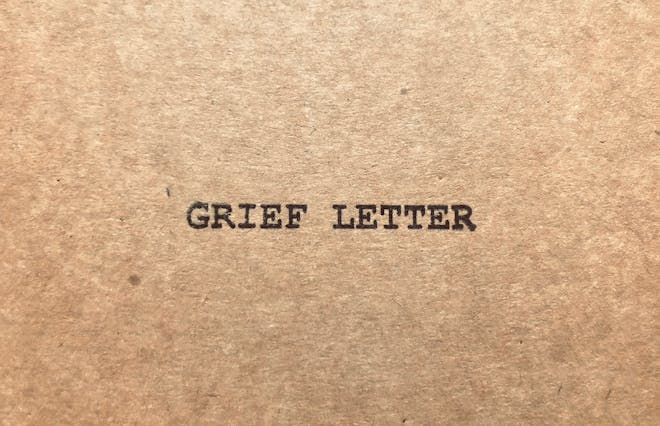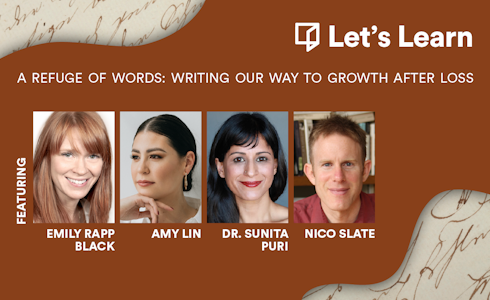Sharing Stories, Healing Hearts: Join the Grief Letter Project


Related Event

“One often calms one’s grief by recounting it.” Pierre Corneille
What is the story?
In the quiet moments of grief, when words seem inadequate and emotions overwhelm, there exists a sacred space for healing—a space often found within the pages of a letter, in the quiet of your own thoughts and space. It is in this spirit of solace and connection that I invite you to join my community project: Grief Letter.
This project grew from my personal story when I lost my dad five years ago, separated by miles. As with any kind of loss, life falls apart into many little pieces, they float in space, trying to connect into a new form of reality. My creative journey as an artist experiences transformation: serene landscapes turned to black expressive charcoal drawings. I started collecting broken objects, pieces of bricks, rusty wire, putting these together again into a new object, giving it a new life and function. This was my subconscious way to repair myself, to understand the enormity of the suffocating feeling that was shadowing me and still is. Grief is a new soulmate one acquires without being asked for one. The more I push it away, the harder it knocks on my door. My paintings and sculptures were tools that carried me above the shifting ground. I turned to writing: unrhymed poetry, collection of words intuitively coming to me. I felt my dad’s presence in this process and wanted to find a way to reach out to him in the form of a letter. Before I managed to write my own, I reached out to the community sharing this idea in 2021 after my solo show. The response has been overwhelming. The grief letters continue landing in my post box bringing the feeling of complete alignment with my values and new outlook on my life. The universe is quietly whispering to me: You are making a difference, keep going.
Why is it useful?
According to research highlighted by Harvard Health, the act of expressing deep emotions through writing has been found to be beneficial for individuals dealing with intense feelings of grief. Grief is a form of learning how to live in the world. Taking a step to write a letter to your loss, helps put emotions, thoughts, and feelings onto paper, can serve as a release, alleviating the stress of holding in those emotions. Writing letters of grief offers a safe and judgment-free space for individuals to freely express themselves, allowing them to explore and reflect on their feelings surrounding the loss without feeling constrained by their thoughts. Firstly, this helps identify the physical representation of loss in your body, since it is an embodied feeling represented by individual emotions. Secondly, this process of expressive writing not only provides emotional relief but also facilitates self-reflection and meaning-making, aiding individuals in navigating the complexities of grief and finding a path toward healing and acceptance. This helps to establish the relationship with your loss. Thirdly, it can serve as a bridge to feel connected again to your loss or the one you lost. As Thich Nhat Hanh said:” If we are able to write such a letter, we feel great relief. The love, understanding and compassion we feel for ourselves will grow as well as the love, understanding and compassion for the other person.”
Every story of loss is unique, yet universally shared. Whether we've lost a loved one, a cherished pet, or even a piece of ourselves, grief is a journey we all navigate in our own way. But amidst the pain, there is power in the written word—a power to soothe, to remember, and to heal. Bringing all these letters together in the exhibition, accompanied by my intuitive response to them through art making, makes the process of grief less isolating. The typical loneliness we experience when struck by grief is damaging to our identity. Sharing these stories of loss, in an empowering way for communal empathy and a sense of belonging.
How to start?
It took me two years to write my own letter. So, take your time and listen to your intuition. Keep asking yourself mentally, “How do I feel today about writing a letter?”. When you feel the moment is right:
Step 1: Begin by finding a quiet, comfortable space where you can be alone with your thoughts. Take this time to reflect before starting your letter, choosing a time of day or night that brings you comfort.
Step 2: Select your preferred writing tool. Ensure it allows your words to flow effortlessly without hindrance. I recommend to hand write. The friction between paper and the tip of your pen and the physical appearance of words on paper validate this moment. You are doing a mindfulness exercise now, you are in the moment, watching your thoughts float while you write them down, materializing them in the physical world.
Step 3: Start by slowly writing the name of the person or the word associated with another type of loss. Write it very slowly, watching how the pen connects to paper. Take 1 min to complete this exercise.
Step 4: Embrace the freedom to express your emotions without judgment. Write openly and honestly, conveying exactly how you feel without worrying about profundity. Consider using a memento, such as a memorial coin or photo keychain, to feel closer to your loved one during the writing process.
Step 5: Take your time to engage in sincere reflection and acceptance. Express your feelings genuinely, whether it's sorrow, love, disappointment, anger, hate, or acknowledgment of their passing.
Step 5: Address any lingering questions or thoughts running through your mind. Jot them down and consider their relevance to your letter, allowing them to guide your expression.
Step 6: If you find it challenging to begin, utilize sentence prompts to jumpstart your writing. These prompts can help structure your thoughts and guide your narrative.
- Write a memory about your who or what you lost.
- What season reminds you of their/this loss?
- Is there a song that reminds you of them?
- What comforts you when you miss them?
Step 7: Write one or two sentences about the present moment. It helps delve into what is gone but also see clearly what is in front of us and what we can build with the broken pieces together and carry with us into the future. This serves as a lens to view the now as a point in time for transformation.
You can develop the letter further by:
Painting it: Use a selection of paints, pencils to transform words into marks. You can use one colour only to represent your loss or make it multicolored. You can draw symbols, objects from memory or simply marks that arise subconsciously. Remember, this process is exploratory and experimental, intended to serve as a journey rather than a destination. Allow yourself the freedom to create without judgment or expectation of a final outcome.
Reading or singing it: This physical act of speaking or singing can help us feel more connected to the words we're expressing, making them feel more real and validated. It's a confirmation that our thoughts and feelings are real and worth expressing, especially when we hear them reflected back to us.
Remember, the grieving process is unique and nonlinear. You may find it takes several letters to fully mourn and express your feelings. Embrace the journey and allow yourself the space to heal at your own pace. There is no right or wrong way to participate. The most important step is simply to take part, embracing the journey of healing with openness and courage.
What do to next?
Connect with me directly by email (info@nataliamillmanart.com) or Instagram (@nataliamillmanart) to express interest and request a free pack if you wish your letter to be featured in my art exhibition promoting grief support. I have collected over 150 letters that include words, sketches, Braille and foreign languages.
My personal useful resources:
Books:
- How to live when a loved one dies by Thich Nhat Hanh
- Creative Ideas to transform grief and difficult life transitions by Karuna Cards
- Drawing on Grief, exploring loss through creativity by Kate Sutton
- It's Ok That You're Not Ok: Meeting Grief and Loss in a Culture That Doesn't Understand Meeting Grief and Loss in a Culture That Doesn't Understand by Megan Devine
- Yoga for Grief and Loss: Poses, Meditation, devotion, Self-Reflection, Selfless Acts, Ritual by Karla Helbert
- The Healing Power of Words: Poems for Healing and Finding Strength After Loss by Dr Michael Mosesian
Poetry:
- Mama Never Forgets Her Birds by Emily Dickinson
- A collection of poems by Mary Oliver
- In Lieu of Flowers by Shawna Lemay
- On the Death of the Beloved by John O’Donohue
- The Window by Rumi
- Kindness by Naomi Shihab Nye
Iconic Artists:
- Kathe Kollwitz
- Tracy Emin
- Edward Munch
- Anselm Kiefer
Contemporary Artists:
- Libby Saylor @libbysaylor
- Carrie Stanley @visual_grief_diary
- Debbie Castro @debscastrow
- Arabelle Brusan @arabellebrusanart
- Angela Blazanovic @angelablazanovic
Coaches and educators:
- Dina Varellas - www.dinavarellas.com
- Tara Nash - www.consciousgrief.co.uk
- Elizabeth Coplan - www.griefdialogues.com
- Jenny Dilts – www.grievingcoach.com
- Charlene Lam - www.charlenelam.com
About Natalia Millman
Natalia Millman is a UK multidisciplinary artist originally from Ukraine. Her intuitive practice explores themes of loss, aging, and the human-nature connection through the incorporation of organic and found materials. She is actively engaged in community projects such as Grief Letter and The Nature of Memories, and runs creative workshops for the Ukrainian community. Millman recently held a solo exhibition, VANISHING POINT, at the Crypt Gallery in London, exploring themes of loss and dementia. As an ambassador of Arts4Dementia, she leads monthly workshops for people living with dementia. Additionally, Millman participates in group and solo exhibitions and currently serves as an artist in residence at Collective Gallery Art in St Albans, UK, curating exhibitions and contributing to community events.
@nataliamillmanart
Related Event



